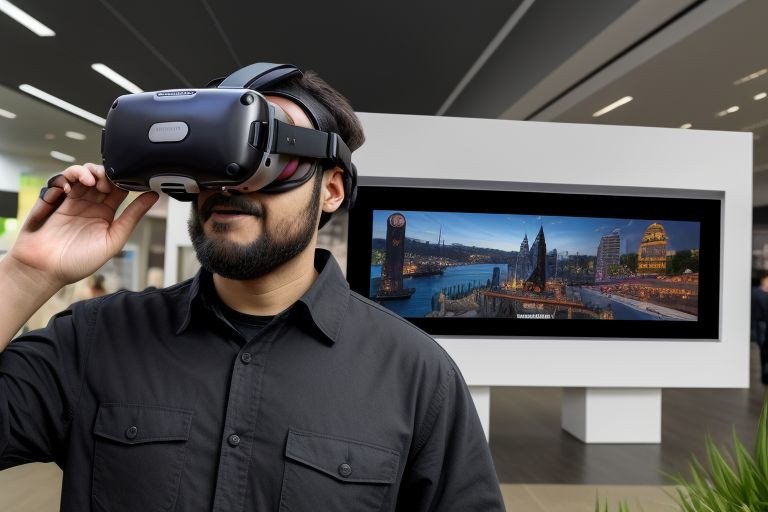Table of Contents
In recent years, both augmented reality (AR) and virtual reality (VR) technologies have gained significant attention in various industries, from gaming and entertainment to education and training. While these technologies share some similarities, they also have distinct differences that make them suitable for different applications.
Understanding Augmented Reality (AR)
Augmented reality is a technology that overlays digital information onto the real world, creating a composite view that enhances the user’s perception of reality. AR applications use devices such as smartphones, tablets, or specialized glasses to display digital content in the user’s field of vision, seamlessly integrating with the real environment.
1.1 Key Features of AR
- Blends digital content with the real world
- Allows users to interact with digital elements in real-time
- Requires a device with a camera and display
- Enhances the user’s perception of reality
1.2 AR Hardware and Software
To experience AR, users typically need a device equipped with a camera, display, and processing power. Smartphones and tablets are the most common devices used for AR applications, as they are widely available and offer the necessary hardware capabilities. Some specialized AR devices, such as Microsoft HoloLens or Magic Leap, provide more advanced features and immersive experiences.
AR software platforms, such as ARKit (Apple) and ARCore (Google), enable developers to create AR applications for mobile devices. These platforms use computer vision algorithms to track the device’s position and orientation, allowing for accurate placement and interaction with digital content in the real world.
Exploring Virtual Reality (VR)
Virtual reality is a technology that creates a completely immersive digital environment, allowing users to experience and interact with a simulated world as if it were real. VR applications use specialized headsets that display stereoscopic images, creating a sense of depth and presence in the virtual environment.
2.1 Key Features of VR
- Creates a fully immersive digital environment
- Provides a sense of presence in the virtual world
- Requires a specialized headset and controllers
- Allows for interactive experiences and simulations
2.2 VR Hardware and Software
To experience VR, users need a specialized headset that displays stereoscopic images, such as the Oculus Rift, HTC Vive, or PlayStation VR. These headsets are equipped with high-resolution displays and motion-tracking sensors and often come with handheld controllers for interaction within the virtual environment.
VR software platforms, such as SteamVR, Oculus, and Unity, provide developers with tools to create immersive VR applications and games. These platforms handle the rendering, tracking, and interaction aspects of VR, allowing developers to focus on creating engaging content and experiences.
Comparing AR and VR
While AR and VR share some similarities, they also have distinct differences that make them suitable for different applications and use cases. Let’s compare these technologies across several key aspects:
3.1 Immersion and Presence
- AR: Augments the real world with digital content, maintaining a connection to the physical environment.
- VR: Creates a fully immersive digital environment, isolating users from the real world and providing a strong sense of presence.
3.2 Interaction and Control
- AR: Allows users to interact with digital content using natural gestures and movements, often through a mobile device’s touchscreen or camera.
- VR: Provides a more intuitive and immersive interaction experience, using handheld controllers or motion tracking to enable users to manipulate objects and navigate the virtual environment.
3.3 Hardware Requirements
- AR: This can be experienced using widely available devices, such as smartphones and tablets, making it more accessible to a broader audience.
- VR: Requires specialized hardware, such as VR headsets and powerful computers, which can be more expensive and less accessible.
3.4 Application Areas
- AR: Well-suited for applications that benefit from blending digital content with the real world, such as product visualization, education, and navigation.
- VR: Ideal for applications that require full immersion and presence, such as gaming, training simulations, and virtual tourism.
Use Cases and Applications
Both AR and VR technologies have numerous potential applications across various industries. Let’s explore some of the most prominent use cases for each technology:
4.1 Augmented Reality Use Cases
- Education and Training: AR can enhance learning experiences by visualizing complex concepts, providing interactive demonstrations, and enabling hands-on practice.
- Product Visualization: AR allows customers to preview products in their environment, helping them make informed purchasing decisions and reducing the need for physical samples.
- Navigation and Tourism: AR can provide real-time information and guidance, enhancing the user’s experience when exploring new places or navigating complex environments.
- Entertainment and Gaming: AR games and experiences blend digital content with the real world, creating engaging and interactive entertainment.
4.2 Virtual Reality Use Cases
- Gaming and Entertainment: VR offers immersive gaming experiences, allowing players to step into virtual worlds and interact with the environment and characters in a more engaging way.
- Training and Simulation: VR can create realistic simulations for training purposes, such as flight simulators, medical training, or emergency response scenarios.
- Virtual Tourism and Experiences: VR enables users to explore remote locations, historical sites, or fictional worlds, providing an immersive and accessible way to experience new places.
- Therapy and Mental Health: VR can be used in therapy sessions to create controlled environments for exposure therapy, relaxation, or cognitive rehabilitation.
Future Developments and Trends
As AR and VR technologies continue to evolve, we can expect to see new developments and trends that will shape their future applications and adoption:
5.1 Advancements in Hardware
- Improved display resolutions and refresh rates for more realistic and comfortable experiences
- Lighter and more ergonomic headsets for extended use
- Better motion tracking and haptic feedback for enhanced immersion and interaction
5.2 Integration with Other Technologies
- Combining AR and VR with artificial intelligence (AI) for more intelligent and adaptive experiences
- Integrating with 5G networks for faster data transmission and lower latency
- Leveraging edge computing for improved performance and reduced reliance on external processing power
5.3 Expanding Application Areas
- Increased adoption in industries such as healthcare, manufacturing, and retail
- Growth in enterprise applications for collaboration, design, and data visualization
- The emergence of new use cases as the technologies become more accessible and affordable
Final Lines
Augmented and virtual reality technologies offer unique opportunities to enhance the way we interact with digital content and experience the world around us. While AR focuses on blending digital elements with the real world, VR creates fully immersive digital environments that transport users to new realities.
As these technologies continue to evolve and mature, we can expect to see an increasing number of applications and use cases across various industries. From education and training to entertainment and therapy, AR and VR have the potential to transform the way we learn, work, and play.
Ultimately, the choice between AR and VR depends on the specific requirements and goals of the application. By understanding the key differences and strengths of each technology, developers and organizations can make informed decisions when creating immersive and engaging experiences for their users.

